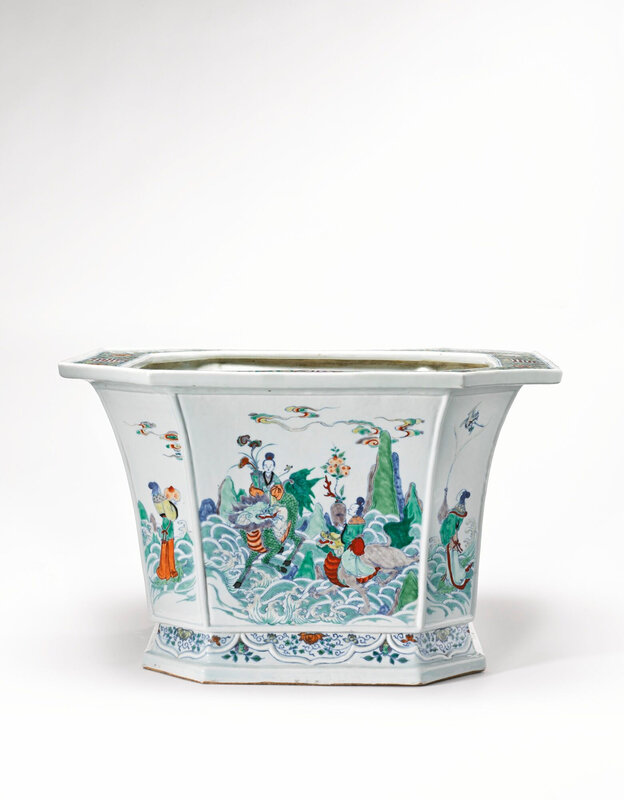A large doucai hexagonal jardinière, Qing Dynasty, Kangxi marks and period (1662-1722)



A large doucai hexagonal jardinière, Qing Dynasty, Kangxi marks and period (1662-1722). Length 20¼ in., 51.5 cm. Photo Sotheby's
Provenance: Private Collection, Milan.
Christie's London, 15th May 2007, lot 282.
Literature: Michel Beurdeley and Guy Raindre, Qing Porcelain: Famille Rose, Famille Verte, London, 1987, p. 58, fig. 62.
Note: Daoist symbols abound on the present piece. The reign marks and fine quality of painting signify it was destined for the imperial palace. However, of the three major faiths, Confucianism was declared the official religion of the Qing dynasty. In 1670, the Kangxi emperor issued the edict of ‘The Sixteen Maxims’, posted in every town and village with the stipulation it be read twice monthly. The seventh maxim warns people to ‘Wipe out strange beliefs to elevate the correct doctrine’ an unsubtle reference to Daoism and Buddhism. The delicate but critical process of building and maintaining a stable empire required that the Kangxi emperor integrate all three pillars of faith into his reign. Through the influence of his grandmother, to whom he was devoted, he became not just a patron but a practitioner of Tibetan Buddhism. An avid student, his knowledge of Laozi’s writings was profound and many of its precepts informed his thinking, yet Daoism seems to have been the most alien to the pragmatically-minded emperor who reportedly scoffed at the notion of ‘immortality elixirs’.
A jardinière very similar to the present but with male Immortals and a barbed rim is in the Qing Court collection and illustrated in The Complete Collection of Treasures of the Palace Museum: Porcelains in Polychrome and Contrasting Colors, Hong Kong, 1999, pp. 210-211, no. 192. A similar pair of jardinières with male daoist immortals and lobed rims was sold at Sotheby's London, 10th July 1979, lot 175. A similar example with male figures figures, a shaped rim and a diaper pattern around the base was sold at Christie’s Hong Kong, 28th November 2005, lot 1336. Another example, also with male daoist immortals, a shaped rim but resting on bracket feet was sold at Sotheby's Hong Kong, 31st October-1st November 1974, lot 271 and again at Christie's New York, 15th-16th September 2011, lot 1549. A planter almost identical to this is illustrated in James Watt, Possessing the Past, Treasures from the National Palace Museum, Taipei, Metropolitan Museum of Art, New York, p. 505, pl. 289. James Watt observes, "The figures in landscapes on the sides of the flowerpot are Taoist immortals, who often decorate Transitional wares, although here the drawing is unmistakably in Ch’ing style, with finer brushwork and greater detail. The trees and figures are all standard representations taken from wood block-printed pattern books and painting manuals. On the flattened lip are shou (longevity) characters, which would indicate this flowerpot was one of a set made for the emperor’s birthday.” ibid, p. 506.
![15055[1024]](https://storage.canalblog.com/17/36/119589/125933875.jpg)
A doucai hexagonal jardinière, Qing Dynasty, Kangxi marks and period (1662-1722), Qing Court collection. © The Palace Museum
According to Peter Lam who has done extensive research into Kangxi reign marks, the present type of large doucai jardinières were produced in the last decade of the period (1713-1722). Lam speculates in “Lang Tinji (1663-1715) and the Porcelain of the Late Kangxi Period” Transactions of the Oriental Ceramic Society, vol. 68, 2003-2004, p. 44, that the present piece was specifically commissioned in honor of the Kangxi emperor’s seventieth birthday which would have occurred in the 3rd month of 1723.
Sotheby's. Embracing Classic Chinese Culture: Kangxi Porcelain from the Jie Rui Tang Collection, New York, 14 march 2014

/https%3A%2F%2Fprofilepics.canalblog.com%2Fprofilepics%2F1%2F0%2F100183.jpg)
/https%3A%2F%2Fstorage.canalblog.com%2F03%2F02%2F119589%2F96711876_o.jpg)
/https%3A%2F%2Fstorage.canalblog.com%2F11%2F31%2F119589%2F94773502_o.jpg)
/https%3A%2F%2Fstorage.canalblog.com%2F20%2F83%2F119589%2F94772815_o.jpg)
/https%3A%2F%2Fstorage.canalblog.com%2F26%2F72%2F119589%2F75604929_o.jpg)
/https%3A%2F%2Fstorage.canalblog.com%2F59%2F60%2F119589%2F26458628_o.jpg)


/image%2F1371349%2F20240416%2Fob_65a1d8_telechargement-31.jpg)
/image%2F1371349%2F20240331%2Fob_7209d9_117-1.jpg)
/image%2F1371349%2F20240324%2Fob_64049b_1.jpg)
/image%2F1371349%2F20240324%2Fob_a0994e_1.jpg)